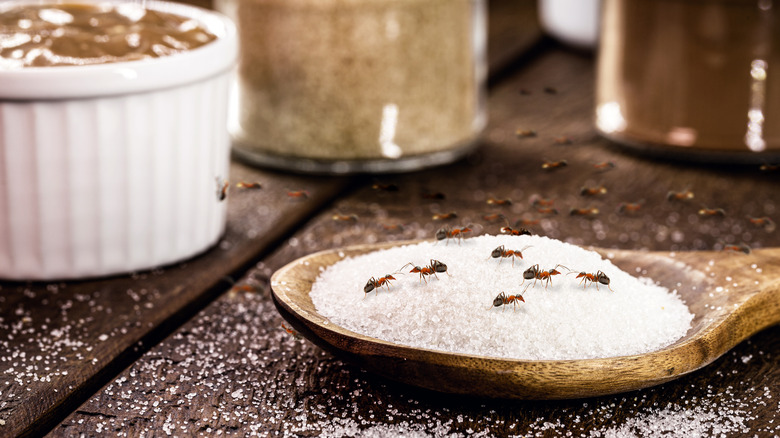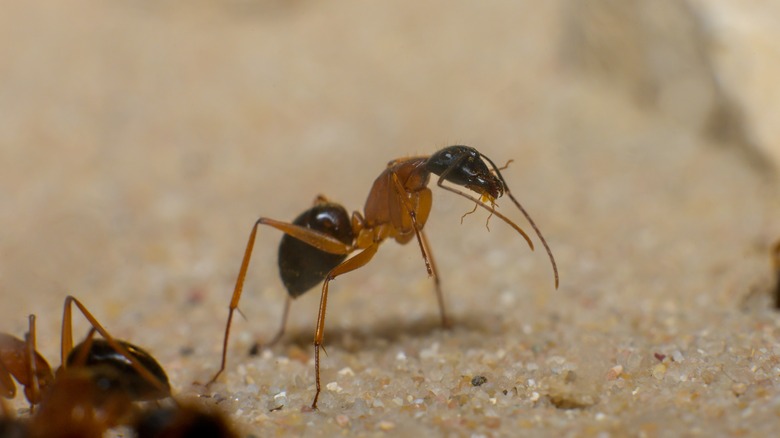The Likely Place You'll Find Sugar Ants If You Have A Bug Problem
Sugar ants are a distinct species known for their indoor nesting habits, differentiating them from the more commonly seen yard ants that build noticeable mounds outdoors. These tiny pests are often found nesting in one particular place — near a water source. This makes them common in areas with ample moisture, such as kitchens and bathrooms. You'll find them nesting near plumbing fixtures and in wall voids, as well as under your flooring or near household appliances that provide a constant water source, such as water heaters. So how do you spot them?
They are typically small, ranging from 2 to 15 millimeters in length, and they are often shades of red to dark brown, sometimes with yellow scabs. A key feature is their segmented antennae, usually bent, and they have large mandibles for their size — a trait that aids in carrying food. What sets them apart from their outdoor counterparts is their attraction to the comforts of a human habitat. This preference for indoor dwelling places means that sugar ants can become a year-round problem, as they are less affected by external weather changes than other ant species.
Sugar ants also exhibit a unique resilience. Their small size allows them to easily infiltrate homes through tiny cracks or gaps, making them a persistent and often frustrating issue for homeowners. The key to their successful invasion lies in their ability to adapt quickly to various environments, thriving in conditions that might be less favorable to other insects. Beyond how they look, understanding their preferences for nesting and foraging can help you successfully identify potential infestation sites. You can then take proactive measures to get rid of these ants and prevent them from becoming a larger issue in your home.
Tracking their movements
When observing sugar ant behavior, you'll notice they are especially drawn to sweet and greasy substances, often found in kitchen pantries or around food preparation areas. They feed anywhere spills and moisture are common, making these areas prime foraging grounds. Since they follow scent trails to food sources, this can lead them across countertops, cabinets, and nearby appliances that hold or process food. In bathrooms, their attraction to moisture is very evident. They can be found near leaky faucets, pipes, and damp areas.
Sugar ants also have a defined breeding cycle, peaking in warmer months. You might witness swarms of winged ants, which are the reproductive members of the colony. After mating, these females start new colonies, rapidly expanding their presence. All in all, awareness of their attraction to food and moisture guides you in anticipating their movements and potential nesting spots.
Effective eradication methods
Eliminating sugar ants requires a multifaceted approach. The first step is to cut off their access to food and water. This means maintaining a clean kitchen, promptly wiping up spills, sealing food in airtight containers, and fixing any leaks or damp areas. Vacuuming regularly, especially along baseboards and under furniture, can remove any food particles that might attract ants. Additionally, regularly inspect of your home for entry points — such as cracks or gaps around windows and doors — and seal them to prevent ants from entering.
Chemical treatments can also be effective, but they should be used cautiously. Baits are popular as they allow ants to carry poison back to their nest, potentially eliminating the colony. However, make sure you choose baits specifically designed for sugar ants. Natural remedies, such as vinegar or essential oils, can deter ants but may not be effective in eliminating an infestation. These methods are best used as preventive measures rather than solutions to an existing problem.
In cases of severe infestation, contact a pest control professional. They can provide a thorough assessment and implement a targeted eradication plan. Professionals have access to more potent treatments and can offer strategies for long-term prevention. Remember: Tackling an infestation early can prevent it from escalating, making it easier to manage and less costly in the long run.


